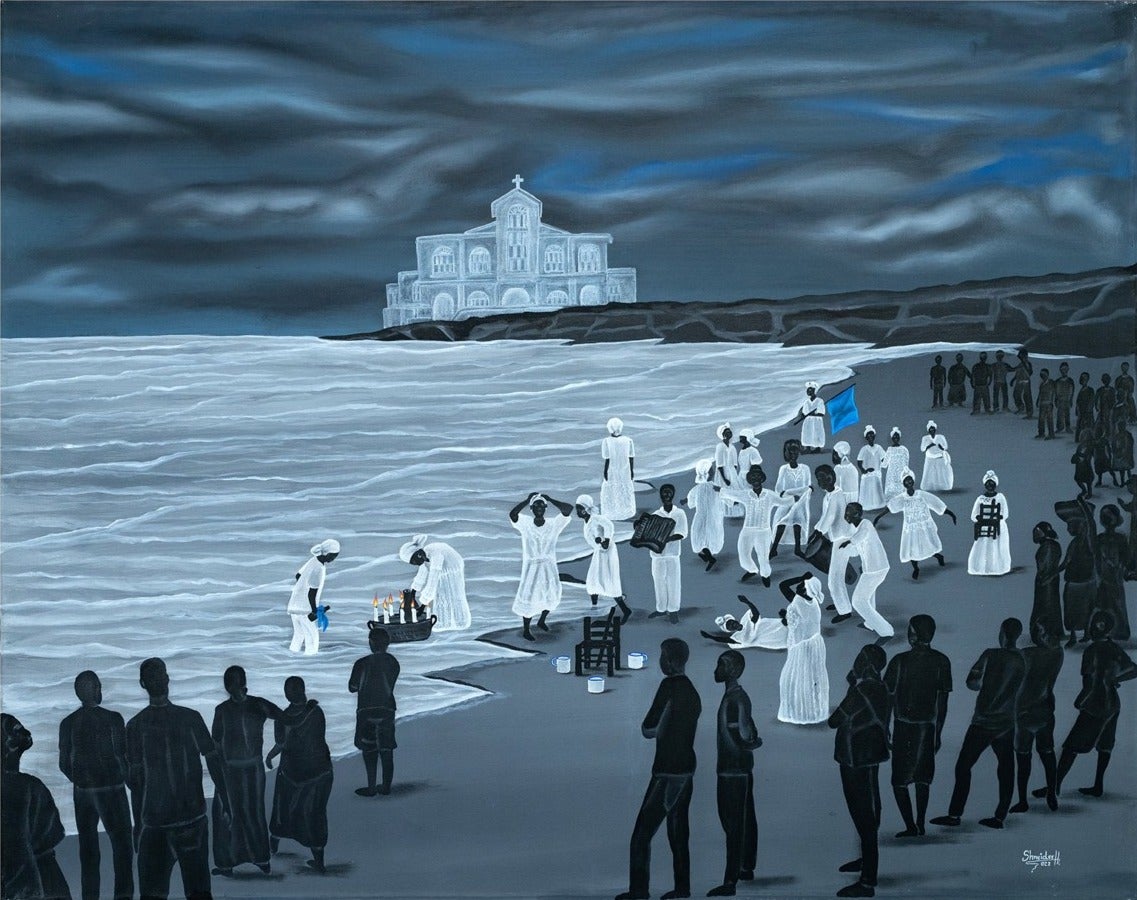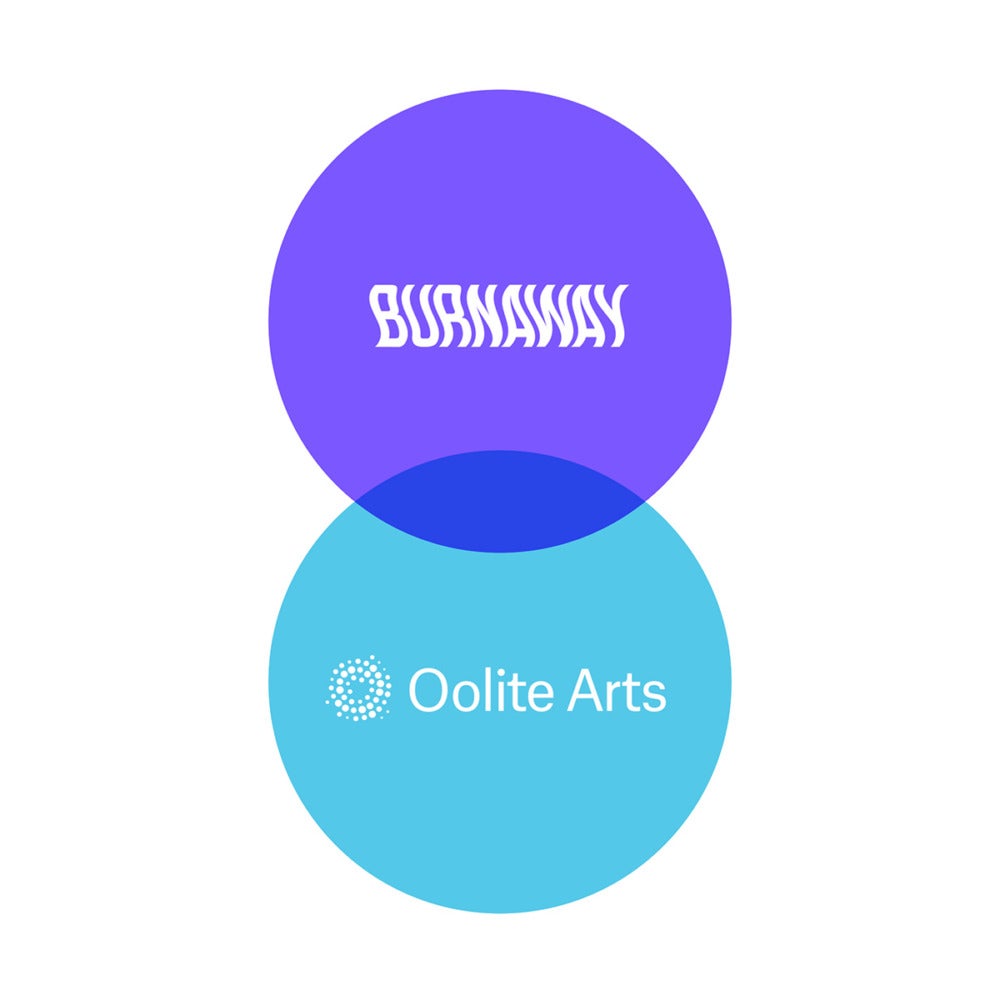
An earlier presentation of the work in Schneider Léon Hilaire’s first exhibit in the United States, Rituals and Ceremonies—currently on view at Green Space Miami—was called Haitian Nights. Though the name for the current body of work is fitting, the paintings also embody the previous name. They are large in scale, imposing and dark in palette; not every tableau is a nighttime scene, but they certainly feel that way. Deep indigo hues and candles pervade landscapes of religious ceremony. According to the show’s curator, Axelle Liautaud, the palette choice by Hilaire was intensely deliberate.
Until 2003, the practice of Vodou was illegal in Haiti. Finally, then-president Jean Bertrand Aristide declared it an official national religion on par with Catholicism. The religion, depicted in Hilaire’s paintings, was performed at nighttime to avoid persecution. The scenes in the paintings possess an air of seclusion because Vodou is practiced heavily in rural Haiti. Electricity is scarce in the countryside so many of these places use candles–votive as they may be, recurring in the work as they may be–as traditional source of light. The palette gives Hilaire the added bonus of subverting a tradition of Haitian painters using bright colors.
As depicted in Hollywood, Vodou is the work of young, cocaine-trafficking hotshots who wield witchcraft and spells as tools for imposing power. Take “Tale of the Goat”, the seventh episode from the second season of Miami Vice. Clarence Williams III plays Legba, a crime boss who comes back from the dead and aligns himself with the Vodou God of Death, Baron Samedi. Ironically, his name is derived from Papa Legba, an Iwe who facilitates communication and understanding.
Depictions of Haitian Vodou as absurd witchcraft and its practitioners as cocaine traffickers don’t just serve Hollywood’s penchant for shocking audiences but also a deeper narrative of American exceptionalism and colonialism. During the American military occupation of Haiti from 1915-1934, Vodou was not just a religion but a method of self-governance. Its practice was a classically Haitian expression of freedom. By the same token though, Vodou has been wielded as a tool by locals of malice.
Vodou has long been used for its symbolism by the political power structure. In her book Farewell Fred Voodoo, author Amy Wilentz writes about the way François Duvalier aka “Papa Doc” used the gods during his dictatorial reign. “Because of his long love affair with death, and his desire to instill fear, Papa Doc chose Baron Samedi, god of the cemetery.” He modeled his Tonton Macoute death squads in slouchy denim outfits typically associated with the peasant god of the fields, Kousin Zaka so that the his tentacles would reach all corners of the country’s folklore.
Rituals and Ceremonies is not about these expressions of power though. “A major part of Vodou,” Liautaud tells me, “Is healing the trauma of being stolen from Africa.” Scenes that, to the outside eye, might be interpreted as violence are in fact quite the opposite. Take Hilaire’s Healing with Medicinal Leaves (Pilé Fey) as an example. In the painting, two healers stand above a robed subject who is lying on the ground. They are mashing ingredients in a large mortar which sits on the subject’s torso. In the background, white-robed healers collect herbs and other medicinal plants from the hillside. The body is not removed from the creation of medicine but rather directly connected to the process.

Healing also comes in the form of a snake. So, in the same way Hilaire subverts common tropes and misconceptions about Vodou and Haitian art, he also positively depicts a creature which has historically been associated with evil. In Ceremony for the Spirit of Fertility (Damballa), worshippers crawl on hands and knees into a rocky pool. At the center of the pool is a barren tree on which a giant specter of a snake sits. This is a depiction of Damballa, the multi-gendered creator of all life whose roots lie in the African country of Benin. Judeo-Christian snakes lead to expulsion from the Garden of Eden, while in Vodou the snake gives life.
Hilaire’s American debut is astonishing. The paintings—most of them at least five-feet tall—are imposing in scale, dark in palette, but also peaceful and comforting. The gallery is populated by a display of items typically used in Vodou ceremonies, including candles, bowls of water, flowers, and beads. The mere presence of his work has inspired conversations—typically in the evening. Stories which might otherwise seem unbelievable in the light of day, all of a sudden feel like the truth against the stillness and mystery of night.
Rituals and Ceremonies is on view at Green Space Miami from May 11-June 9, 2023.

This piece was published in partnership with Oolite Arts as part of a project to increase critical arts coverage in Miami-Dade County.




